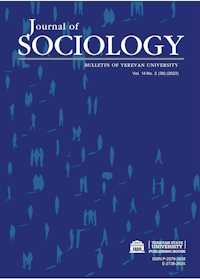The Structural Model of Dynamics of Political Loyalty of Yerevan Population
DOI:
https://doi.org/10.46991/BYSU:F/2023.14.2.007Keywords:
structural equation modeling, political loyalty, “velvet revolution”, 44-day war, strategic planning, strategic managementAbstract
Recently the general background of political processes in Armenia is the low loyalty in Armenian society to the country's political course and the low level of trust in the party system. The article presents a model of the dynamics of general loyalty of the population, in particular loyalty to the country's political course among the population of Yerevan. The model is based on data from a representative sociological survey conducted in Yerevan in November 2022. We construct the model by the structural equation modeling method. It represents the direction and the force of various factors that influence the level of loyalty of the population. In the model the factor “Loyalty” represents the acceptability of the country’s political course, trust in the political leaders, and trust in the State officials. The model shows that the factor “Revolution” determining the level of acceptability of the "velvet revolution" 2018 and the level of realization of expectations from the revolution, has the maximum influence on the level of “Loyalty”. The relative strength of the factor is 0.51. The higher the realization of expectations, the higher the level of “Loyalty” all other things being equal. The second is the factor “Economy” which determines the positive perceptions of the country's economic state, positive changes over the past year, and positive expectations for the future. The relative strength of the factor is 0.22. The higher the value of the factor, the higher the “Loyalty” all other things being equal. The third is the factor “War” which determines the society’s estimates of missed opportunities during the 44-day war, including the possibility to prevent the war, the possibility to reduce the losses from military defeat, and the possibility to win the war. The relative strength of the factor is -0.16. The more acutely society perceives missed opportunities, the lower the “Loyalty” other things being equal. These factors explain 48% of the variance in “Loyalty”. The results of the analysis of the model and its complete structure can serve as a scientific basis for strategic planning and management in the field of problems related to the political loyalty of the population.
References
Atanesyan A., Mkrtichyan A. (2023). Youth perceptions of the war in Ukraine and its possible consequences (on the case of Armenian youth in Yerevan) Journal of Sociology: Bulletin of Yerevan University, Vol. 14 1(37), pp. 07-28․ DOI 10.46991/BYSU:F/2023.14.1.007
Atanesyan A.V., Mkrtichyan A.E. (2022) Armenia between Russia and the West: Foreign Political Priorities in Public Opinion. Sotsiologicheskie issledovaniya [Sociological Studies]. No 12. P. 88-100 DOI 10.31857/S013216250022088-9 (in Russian)
Berndt, A.E. (1998). "Typical" model features and their effects on goodness-of-fit indices. Presented at the 106th Annual Convention of the American Psychological Association, San Francisco, CA. http://reifman-sem.blogspot.com/2007/02/at-wednesdays-class-well-make-sure.html#:~:text=The%20AMOS%20output%20will%20report,and%20thus%20usually%20produces%20results
Holbert, Ch. (2023) Sample Size Determination for Correlation Studies․ March 25. URL: https://www.cfholbert.com/blog/sample-size-correlation/#:~:text= As%20a%20final%20note%2C%20the,power%2C%20even%20with%20large%20samples
Igolkina, A.A., Samsonova M.G. (2018) Method SEM: Structural equation modeling in molecular biology. Biophizika [Biophisics]. V. 63, № 2. pp. 213-224. (in Russian)
Kline R.B. (2005) Principles and practice of structural equation modeling. The Guilford Press, 2005.
Miljko (2020) Statistische Beratung Leonardo Miljko․ How to interpret SEM model fit results in AMOS. URL: https://www.Statistische DatenAnalyse.de/images/services/How_to_interpret_SEM_model_fit_results_in_AMOS.pdf .
Ostipenko R.I. (2013) Brief overview and prospects for the development of structural modeling methods in domestic science and practice. Perspektivy nauki I obrazovaniya [Prospects for science and education]. № 5, pp. 56-99 (in Russian).
Downloads
Published
How to Cite
Issue
Section
License
Copyright (c) 2023 Samvel Manukyan

This work is licensed under a Creative Commons Attribution-NonCommercial 4.0 International License.








